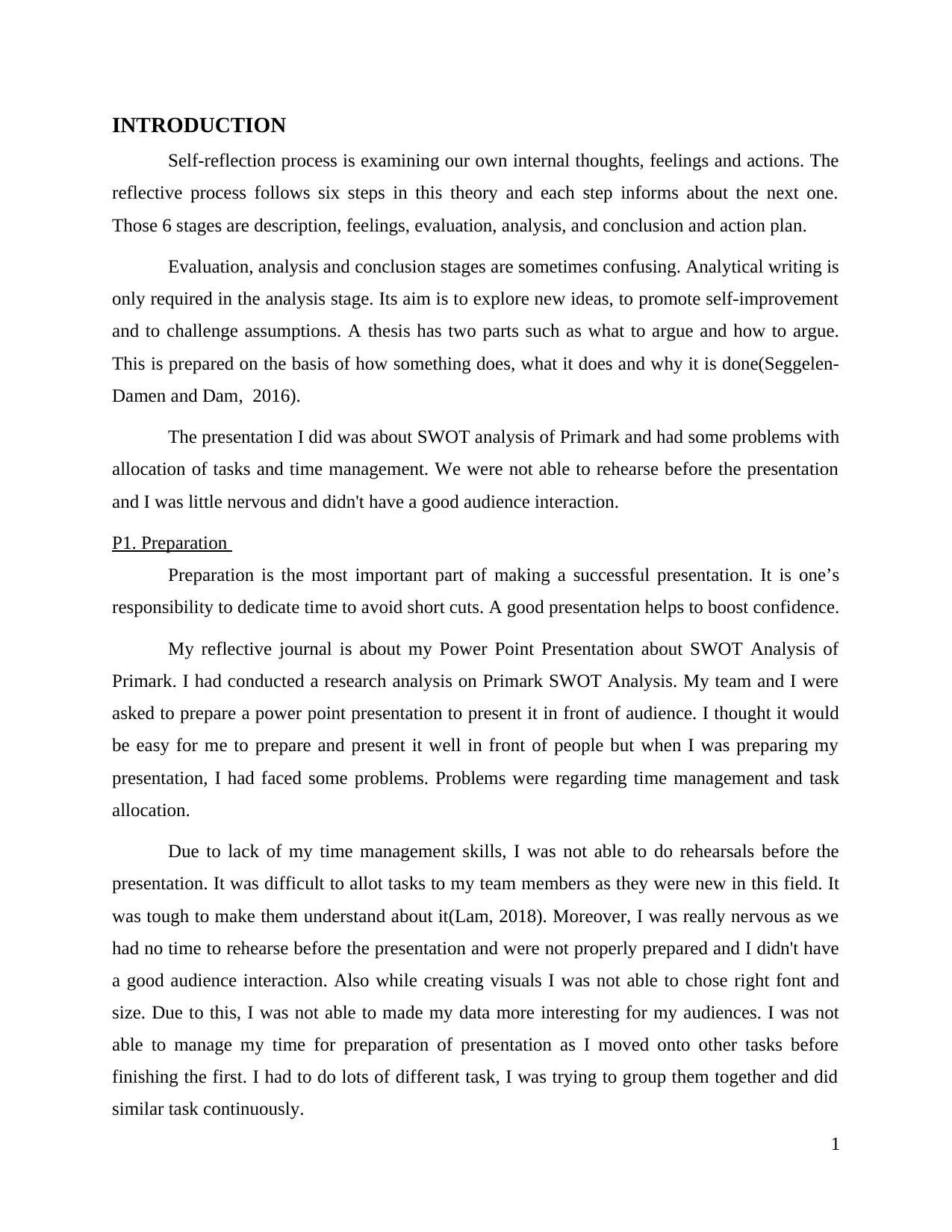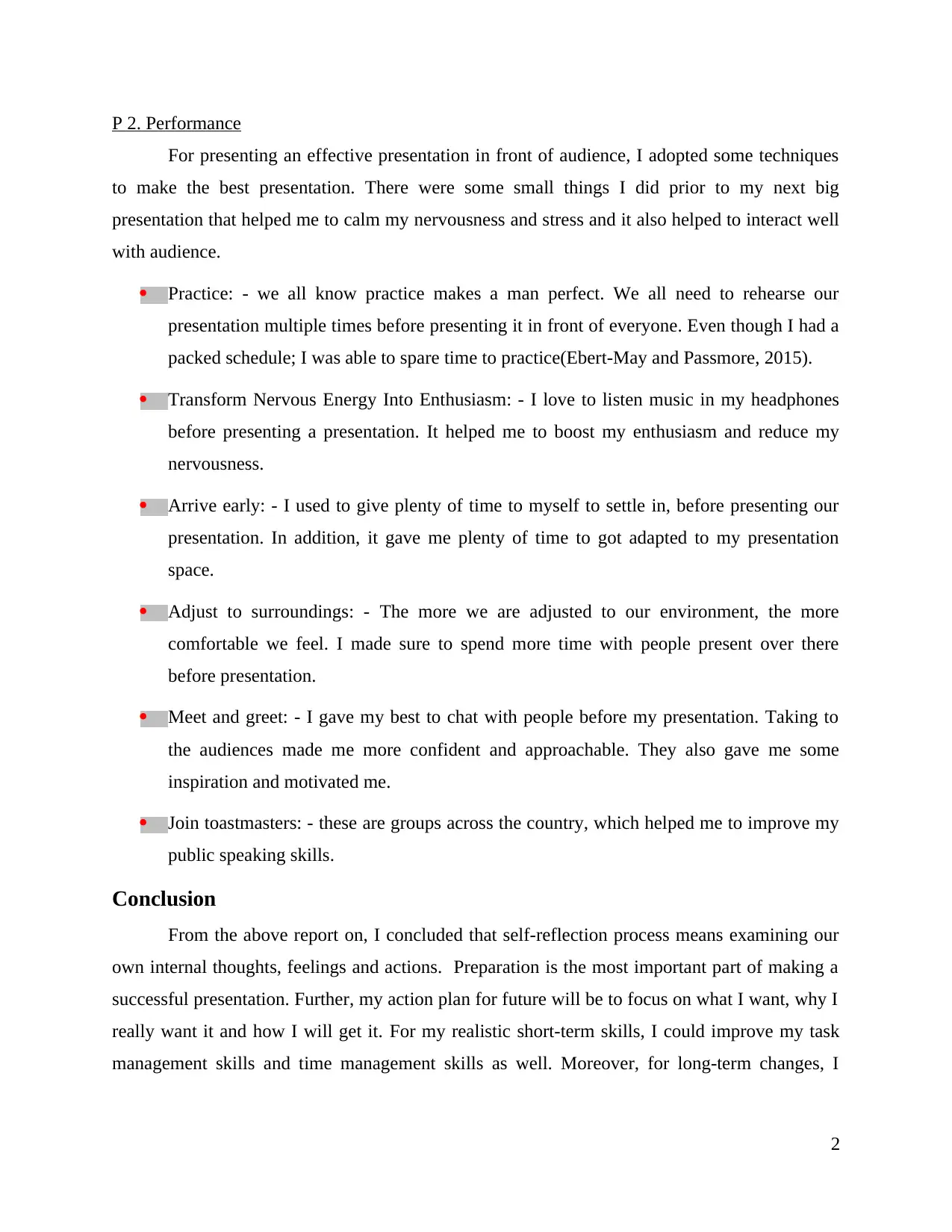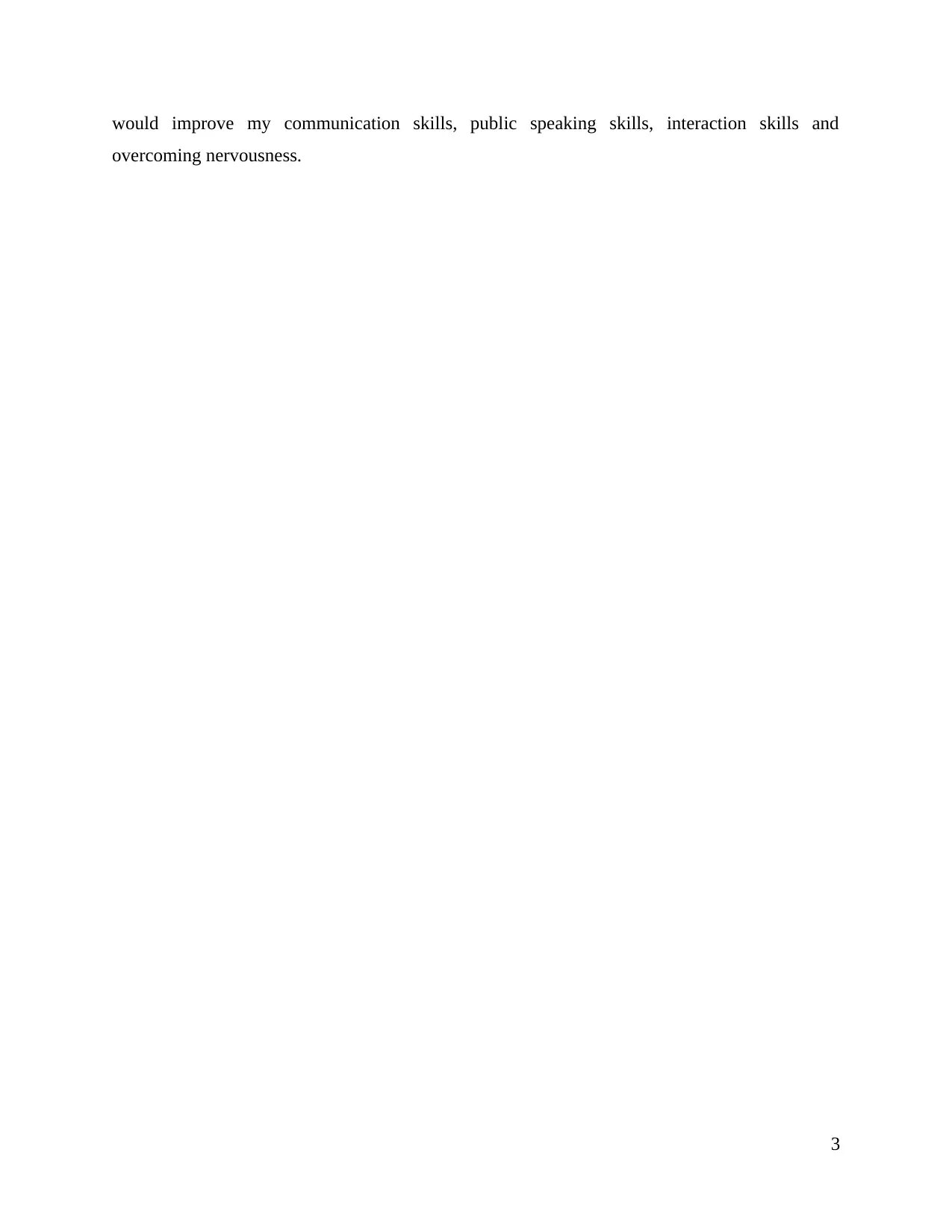Reflective Journal: Analysis of SWOT Presentation on Primark
VerifiedAdded on 2020/10/22
|6
|1015
|437
Journal and Reflective Writing
AI Summary
This reflective journal analyzes a student's experience preparing and delivering a SWOT analysis presentation on Primark. The journal details the preparation phase, highlighting challenges in task allocation, time management, and rehearsal limitations. The student reflects on nervousness, audience interaction, and visual design choices. The performance section discusses techniques employed to mitigate nervousness, such as practicing, listening to music, arriving early, adjusting to the surroundings, and interacting with the audience. The conclusion summarizes the self-reflection process, emphasizing the importance of preparation. The student outlines an action plan for future presentations, focusing on improving task management, time management, communication, public speaking, and interaction skills to overcome nervousness. References to academic sources support the self-reflection process.

Reflective journal
Paraphrase This Document
Need a fresh take? Get an instant paraphrase of this document with our AI Paraphraser

TABLE OF CONTENTS
INTRODUCTION...........................................................................................................................1
P1 Preparation ............................................................................................................................1
P2 Performances..........................................................................................................................2
CONCLUSION................................................................................................................................2
REFERENCES................................................................................................................................3
INTRODUCTION...........................................................................................................................1
P1 Preparation ............................................................................................................................1
P2 Performances..........................................................................................................................2
CONCLUSION................................................................................................................................2
REFERENCES................................................................................................................................3

INTRODUCTION
Self-reflection process is examining our own internal thoughts, feelings and actions. The
reflective process follows six steps in this theory and each step informs about the next one.
Those 6 stages are description, feelings, evaluation, analysis, and conclusion and action plan.
Evaluation, analysis and conclusion stages are sometimes confusing. Analytical writing is
only required in the analysis stage. Its aim is to explore new ideas, to promote self-improvement
and to challenge assumptions. A thesis has two parts such as what to argue and how to argue.
This is prepared on the basis of how something does, what it does and why it is done(Seggelen-
Damen and Dam, 2016).
The presentation I did was about SWOT analysis of Primark and had some problems with
allocation of tasks and time management. We were not able to rehearse before the presentation
and I was little nervous and didn't have a good audience interaction.
P1. Preparation
Preparation is the most important part of making a successful presentation. It is one’s
responsibility to dedicate time to avoid short cuts. A good presentation helps to boost confidence.
My reflective journal is about my Power Point Presentation about SWOT Analysis of
Primark. I had conducted a research analysis on Primark SWOT Analysis. My team and I were
asked to prepare a power point presentation to present it in front of audience. I thought it would
be easy for me to prepare and present it well in front of people but when I was preparing my
presentation, I had faced some problems. Problems were regarding time management and task
allocation.
Due to lack of my time management skills, I was not able to do rehearsals before the
presentation. It was difficult to allot tasks to my team members as they were new in this field. It
was tough to make them understand about it(Lam, 2018). Moreover, I was really nervous as we
had no time to rehearse before the presentation and were not properly prepared and I didn't have
a good audience interaction. Also while creating visuals I was not able to chose right font and
size. Due to this, I was not able to made my data more interesting for my audiences. I was not
able to manage my time for preparation of presentation as I moved onto other tasks before
finishing the first. I had to do lots of different task, I was trying to group them together and did
similar task continuously.
1
Self-reflection process is examining our own internal thoughts, feelings and actions. The
reflective process follows six steps in this theory and each step informs about the next one.
Those 6 stages are description, feelings, evaluation, analysis, and conclusion and action plan.
Evaluation, analysis and conclusion stages are sometimes confusing. Analytical writing is
only required in the analysis stage. Its aim is to explore new ideas, to promote self-improvement
and to challenge assumptions. A thesis has two parts such as what to argue and how to argue.
This is prepared on the basis of how something does, what it does and why it is done(Seggelen-
Damen and Dam, 2016).
The presentation I did was about SWOT analysis of Primark and had some problems with
allocation of tasks and time management. We were not able to rehearse before the presentation
and I was little nervous and didn't have a good audience interaction.
P1. Preparation
Preparation is the most important part of making a successful presentation. It is one’s
responsibility to dedicate time to avoid short cuts. A good presentation helps to boost confidence.
My reflective journal is about my Power Point Presentation about SWOT Analysis of
Primark. I had conducted a research analysis on Primark SWOT Analysis. My team and I were
asked to prepare a power point presentation to present it in front of audience. I thought it would
be easy for me to prepare and present it well in front of people but when I was preparing my
presentation, I had faced some problems. Problems were regarding time management and task
allocation.
Due to lack of my time management skills, I was not able to do rehearsals before the
presentation. It was difficult to allot tasks to my team members as they were new in this field. It
was tough to make them understand about it(Lam, 2018). Moreover, I was really nervous as we
had no time to rehearse before the presentation and were not properly prepared and I didn't have
a good audience interaction. Also while creating visuals I was not able to chose right font and
size. Due to this, I was not able to made my data more interesting for my audiences. I was not
able to manage my time for preparation of presentation as I moved onto other tasks before
finishing the first. I had to do lots of different task, I was trying to group them together and did
similar task continuously.
1
⊘ This is a preview!⊘
Do you want full access?
Subscribe today to unlock all pages.

Trusted by 1+ million students worldwide

P 2. Performance
For presenting an effective presentation in front of audience, I adopted some techniques
to make the best presentation. There were some small things I did prior to my next big
presentation that helped me to calm my nervousness and stress and it also helped to interact well
with audience.
Practice: - we all know practice makes a man perfect. We all need to rehearse our
presentation multiple times before presenting it in front of everyone. Even though I had a
packed schedule; I was able to spare time to practice(Ebert-May and Passmore, 2015).
Transform Nervous Energy Into Enthusiasm: - I love to listen music in my headphones
before presenting a presentation. It helped me to boost my enthusiasm and reduce my
nervousness.
Arrive early: - I used to give plenty of time to myself to settle in, before presenting our
presentation. In addition, it gave me plenty of time to got adapted to my presentation
space.
Adjust to surroundings: - The more we are adjusted to our environment, the more
comfortable we feel. I made sure to spend more time with people present over there
before presentation.
Meet and greet: - I gave my best to chat with people before my presentation. Taking to
the audiences made me more confident and approachable. They also gave me some
inspiration and motivated me.
Join toastmasters: - these are groups across the country, which helped me to improve my
public speaking skills.
Conclusion
From the above report on, I concluded that self-reflection process means examining our
own internal thoughts, feelings and actions. Preparation is the most important part of making a
successful presentation. Further, my action plan for future will be to focus on what I want, why I
really want it and how I will get it. For my realistic short-term skills, I could improve my task
management skills and time management skills as well. Moreover, for long-term changes, I
2
For presenting an effective presentation in front of audience, I adopted some techniques
to make the best presentation. There were some small things I did prior to my next big
presentation that helped me to calm my nervousness and stress and it also helped to interact well
with audience.
Practice: - we all know practice makes a man perfect. We all need to rehearse our
presentation multiple times before presenting it in front of everyone. Even though I had a
packed schedule; I was able to spare time to practice(Ebert-May and Passmore, 2015).
Transform Nervous Energy Into Enthusiasm: - I love to listen music in my headphones
before presenting a presentation. It helped me to boost my enthusiasm and reduce my
nervousness.
Arrive early: - I used to give plenty of time to myself to settle in, before presenting our
presentation. In addition, it gave me plenty of time to got adapted to my presentation
space.
Adjust to surroundings: - The more we are adjusted to our environment, the more
comfortable we feel. I made sure to spend more time with people present over there
before presentation.
Meet and greet: - I gave my best to chat with people before my presentation. Taking to
the audiences made me more confident and approachable. They also gave me some
inspiration and motivated me.
Join toastmasters: - these are groups across the country, which helped me to improve my
public speaking skills.
Conclusion
From the above report on, I concluded that self-reflection process means examining our
own internal thoughts, feelings and actions. Preparation is the most important part of making a
successful presentation. Further, my action plan for future will be to focus on what I want, why I
really want it and how I will get it. For my realistic short-term skills, I could improve my task
management skills and time management skills as well. Moreover, for long-term changes, I
2
Paraphrase This Document
Need a fresh take? Get an instant paraphrase of this document with our AI Paraphraser

would improve my communication skills, public speaking skills, interaction skills and
overcoming nervousness.
3
overcoming nervousness.
3

References
Seggelen-Damen, I. V. and Dam, K. V., 2016. Self-reflection as a mediator between self-
efficacy and well-being. Journal of Managerial Psychology. 31(1). pp.18-33.
Lam, R., 2018. Promoting self-reflection in writing: A showcase portfolio approach. In
International Perspectives on Teaching the Four Skills in ELT (pp. 219-231). Palgrave
Macmillan, Cham.
Ebert-May, D., and Passmore, H. A., 2015. Breaking the cycle: Future faculty begin teaching
with learner-centered strategies after professional development. CBE—Life Sciences
Education. 14(2). p.ar22.
Jimenez Garcia, J. C., Romero Herrera, N. A., Keyson, D. V. and Havinga, P., 2014. Reflective
Healthcare Systems: Micro-Cycle of Self-Reflection to empower users. Interaction Design
and Architecture (s).(23). 2014.
4
Seggelen-Damen, I. V. and Dam, K. V., 2016. Self-reflection as a mediator between self-
efficacy and well-being. Journal of Managerial Psychology. 31(1). pp.18-33.
Lam, R., 2018. Promoting self-reflection in writing: A showcase portfolio approach. In
International Perspectives on Teaching the Four Skills in ELT (pp. 219-231). Palgrave
Macmillan, Cham.
Ebert-May, D., and Passmore, H. A., 2015. Breaking the cycle: Future faculty begin teaching
with learner-centered strategies after professional development. CBE—Life Sciences
Education. 14(2). p.ar22.
Jimenez Garcia, J. C., Romero Herrera, N. A., Keyson, D. V. and Havinga, P., 2014. Reflective
Healthcare Systems: Micro-Cycle of Self-Reflection to empower users. Interaction Design
and Architecture (s).(23). 2014.
4
⊘ This is a preview!⊘
Do you want full access?
Subscribe today to unlock all pages.

Trusted by 1+ million students worldwide
1 out of 6
Related Documents
Your All-in-One AI-Powered Toolkit for Academic Success.
+13062052269
info@desklib.com
Available 24*7 on WhatsApp / Email
![[object Object]](/_next/static/media/star-bottom.7253800d.svg)
Unlock your academic potential
Copyright © 2020–2025 A2Z Services. All Rights Reserved. Developed and managed by ZUCOL.



